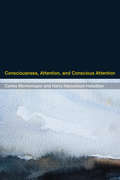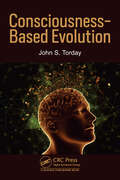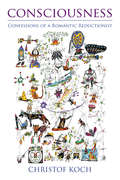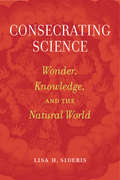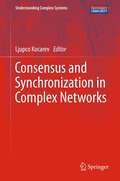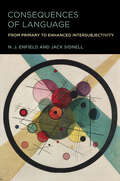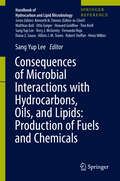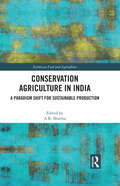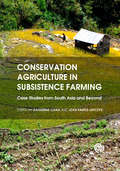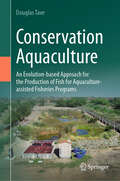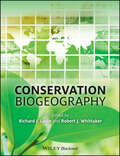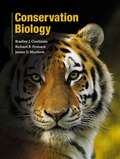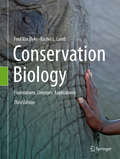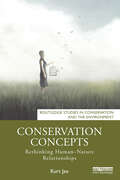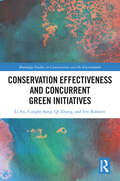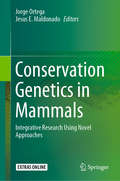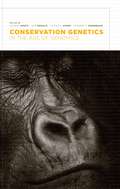- Table View
- List View
Consciousness, Attention, and Conscious Attention (The\mit Press Ser.)
by Carlos Montemayor Harry Haroutioun HaladjianA rigorous analysis of current empirical and theoretical work supporting the argument that consciousness and attention are largely dissociated.In this book, Carlos Montemayor and Harry Haladjian consider the relationship between consciousness and attention. The cognitive mechanism of attention has often been compared to consciousness, because attention and consciousness appear to share similar qualities. But, Montemayor and Haladjian point out, attention is defined functionally, whereas consciousness is generally defined in terms of its phenomenal character without a clear functional purpose. They offer new insights and proposals about how best to understand and study the relationship between consciousness and attention by examining their functional aspects. The book's ultimate conclusion is that consciousness and attention are largely dissociated. Undertaking a rigorous analysis of current empirical and theoretical work on attention and consciousness, Montemayor and Haladjian propose a spectrum of dissociation—a framework that identifies the levels of dissociation between consciousness and attention—ranging from identity to full dissociation. They argue that conscious attention, the focusing of attention on the contents of awareness, is constituted by overlapping but distinct processes of consciousness and attention. Conscious attention, they claim, evolved after the basic forms of attention, increasing access to the richest kinds of cognitive contents.Montemayor and Haladjian's goal is to help unify the study of consciousness and attention across the disciplines. A focused examination of conscious attention will, they believe, enable theoretical progress that will further our understanding of the human mind.
Consciousness-Based Evolution
by John S. TordayConsciousness is the key to understanding human existence. Many have attempted to determine the fundamental nature of consciousness based on deductive reasoning. In contrast to that, Consciousness-Based Evolution has exploited empiric evidence for the evolution of physiology from the unicell to man based on cell-cell communication as the origin of consciousness, each intermediary step representing an innate effort to maintain homeostasis by harnessing the energy flow initiated by The Big Bang. By tracing vertebrate evolution as development and phylogeny, focusing on specific emergent steps using a Bayesian approach, individual traits can be seen as exaptations of earlier ways in which existential threats were resolved over the course of evolution. You, the readers, are the beneficiary of those insights.
Consciousness: A Ladybird Expert Book (The Ladybird Expert Series #29)
by Hannah CritchlowPart of the ALL-NEW LADYBIRD EXPERT SERIES.____________Are other animals, or even plants, conscious?Can we create conscious robots?Are we able to assume the consciousness of someone else?We all experience the world differently.REALITY is shaped by our individual memories.So we respond to THE WORLD in our own ways.Our UNIQUE EXPERIENCE underpins what it means to be CONSCIOUS.This raises so many questions such as where does consciousness live? And what is it for?Discover the answers and more inside Hannah Critchlow's Ladybird Expert - Consciousness, the thrilling and accessible account that explains what it means to be conscious - from what defines it, to questioning the existence of free will.
Consciousness: Confessions of a Romantic Reductionist (The\mit Press Ser.)
by Christof KochIn which a scientist searches for an empirical explanation for phenomenal experience, spurred by his instinctual belief that life is meaningful.What links conscious experience of pain, joy, color, and smell to bioelectrical activity in the brain? How can anything physical give rise to nonphysical, subjective, conscious states? Christof Koch has devoted much of his career to bridging the seemingly unbridgeable gap between the physics of the brain and phenomenal experience. This engaging book—part scientific overview, part memoir, part futurist speculation—describes Koch's search for an empirical explanation for consciousness. Koch recounts not only the birth of the modern science of consciousness but also the subterranean motivation for his quest—his instinctual (if "romantic") belief that life is meaningful.Koch describes his own groundbreaking work with Francis Crick in the 1990s and 2000s and the gradual emergence of consciousness (once considered a "fringy" subject) as a legitimate topic for scientific investigation. Present at this paradigm shift were Koch and a handful of colleagues, including Ned Block, David Chalmers, Stanislas Dehaene, Giulio Tononi, Wolf Singer, and others. Aiding and abetting it were new techniques to listen in on the activity of individual nerve cells, clinical studies, and brain-imaging technologies that allowed safe and noninvasive study of the human brain in action. Koch gives us stories from the front lines of modern research into the neurobiology of consciousness as well as his own reflections on a variety of topics, including the distinction between attention and awareness, the unconscious, how neurons respond to Homer Simpson, the physics and biology of free will, dogs, Der Ring des Nibelungen, sentient machines, the loss of his belief in a personal God, and sadness. All of them are signposts in the pursuit of his life's work—to uncover the roots of consciousness.
Consecrating Science: Wonder, Knowledge, and the Natural World
by Lisa H. SiderisDebunking myths behind what is known collectively as the new cosmology—a grand, overlapping set of narratives that claim to bring science and spirituality together—Lisa H. Sideris offers a searing critique of the movement’s anthropocentric vision of the world. In Consecrating Science, Sideris argues that instead of cultivating an ethic of respect for nature, the new cosmology encourages human arrogance, uncritical reverence for science, and indifference to nonhuman life. Exploring moral sensibilities rooted in experience of the natural world, Sideris shows how a sense of wonder can foster environmental attitudes that will protect our planet from ecological collapse for years to come.
Consensus and Synchronization in Complex Networks (Understanding Complex Systems)
by Ljupco KocarevIn this book for the first time two scientific fields - consensus formation and synchronization of communications - are presented together and examined through their interrelational aspects, of rapidly growing importance. Both fields have indeed attracted enormous research interest especially in relation to complex networks. In networks of dynamic systems (or agents), consensus means to reach an agreement regarding a certain quantity of interest that depends on the state of all dynamical systems (agents). Consensus problems have a long history in control theory and computer sciences, and form the foundation of the field of distributed computing. Synchronization, which defines correlated-in-time behavior between different processes and roots going back to Huygens to the least, is now a highly popular, exciting and rapidly developing topic, with applications ranging from biological networks to mathematical epidemiology, and from processing information in the brain to engineering of communications devices. The book reviews recent finding in both fields and describes novel approaches to consensus formation, where consensus is realized as an instance of the nonlinear dynamics paradigm of chaos synchronization. The chapters are written by world-known experts in both fields and cover topics ranging from fundaments to various applications of consensus and synchronization.
Consequences of Language: From Primary to Enhanced Intersubjectivity
by Jack Sidnell N. J. EnfieldWhat is it about humans that makes language possible, and what is it about language that makes us human?If you are reading this, you have done something that only our species has evolved to do. You have acquired a natural language. This book asks, How has this changed us? Where scholars have long wondered what it is about humans that makes language possible, N. J. Enfield and Jack Sidnell ask instead, What is it about humans that is made possible by language? In Consequences of Language their objective is to understand what modern language really is and to identify its logical and conceptual consequences for social life. Central to this undertaking is the concept of intersubjectivity, the open sharing of subjective experience. There is, Enfield and Sidnell contend, a uniquely human form of intersubjectivity, and it is essentially intertwined with language in two ways: a primary form of intersubjectivity was necessary for language to have begun evolving in our species in the first place and then language, through its defining reflexive properties, transformed the nature of our intersubjectivity. In the authors&’ analysis, social accountability—the bedrock of society—is grounded in this linguistically transformed, enhanced kind of intersubjectivity.The account of the language-mind-society connection put forward in Consequences of Language is one of unprecedented reach, suggesting new connections across disciplines centrally concerned with language—from anthropology and philosophy to sociology and cognitive science—and among those who would understand the foundational role of language in making us human.
Consequences of Microbial Interactions with Hydrocarbons, Oils, and Lipids: Production of Fuels and Chemicals (Handbook Of Hydrocarbon And Lipid Microbiology Ser.)
by Sang Yup LeeThis book covers the current states of microbial and related technologies that have been developed for the efficient production of chemicals, fuels and materials by integrating strain and enzyme development, fermentation processes, and downstream processes. The book also covers how microbes and microbial products can be employed to facilitate petroleum recovery. Global consequences of bio-based production of chemicals, fuels and materials are also discussed with insights.
Conservation Across Borders: Biodiversity in an Interdependent World
by Charles C. ChesterConservationists have long been aware that politicalboundaries rarely coincide with natural boundaries.From the establishment of early "peace parks"to thedesignation of continental migratory pathways, awide range of transborder mechanisms to protectbiodiversity have been established by conservationistsin both the public and private sectors.Conservation Across Borders presents a broadoverview of the history of transboundary conservationefforts and an accessible introduction to current issues surroundingthe subject. Through detailed examinations of two initiatives, theInternational Sonoran Desert Alliance (ISDA) and the Yellowstone toYukon Initiative (Y2Y), the book helps readers understand the benefitsand challenges of landscape-scale protection.In addition to discussing general concepts and the specific experienceof ISDA and Y2Y, the author considers the emerging concept of "conservationeffectiveness" and offers a comparative analysis of the twoprojects. The book ends with a discussion of the complex relationshipsamong civil society, governments, and international borders.By considering the history, goals, successes, and failures of two divergentinitiatives, the book offers important insights into the field oftransborder conservation along with valuable lessons for those studyingor working in the field.
Conservation Agriculture in India: A Paradigm Shift for Sustainable Production (Earthscan Food and Agriculture)
by A. R. SharmaThis book examines the current situation, levels of adoption, management practices, and the future outlook of conservation agriculture in India, and also in other tropical and subtropical regions of the world. While conservation agriculture is proposed as an important means to combat climate change, improve crop productivity and food affordability, and to protect the environment, the adoption of conservation agriculture in India, and south-east Asia more broadly, has been slow. This volume reflects on the current status of conservation agriculture in India, asking why adoption has been slow and putting forward strategies to improve its uptake. The chapters cover the various aspects of crop management such as soil, water, nutrients, weeds, crop residues, machinery, and energy, in a range of environments, including irrigated and rainfed regions. The impact of climate change and the economic considerations behind the adoption of conservation agriculture are also discussed. The volume concludes by discussing the future outlook for conservation agriculture in India, in particular drawing out parallels with other tropical and subtropical regions of the world. This book will be of great interest to students and scholars of conservation agriculture, sustainable agriculture, crop and soil management, and environmental and natural resource management.
Conservation Agriculture in Subsistence Farming: Case Studies from South Asia and Beyond
by Jean Fantle-Lepczyk Jacqueline Jacqueline Dr Catherine Chan Aliza Aliza Bikash Bikash Travis TravisConservation agriculture systems have long-term impacts on livelihoods, agricultural production, gender equity, and regional economic development of tribal societies in South Asia. This book presents South Asia as a case study, due to the high soil erosion caused by monsoon rainfall and geophysical conditions in the region, which necessitate conservation agriculture approaches, and the high percentage of people in South Asia relying on subsistence and traditional farming. The book takes an interdisciplinary approach to analyse systems at scales ranging from household to regional and national levels.
Conservation Agriculture in Subsistence Farming: Case Studies from South Asia and Beyond
by Jacqueline Jacqueline Aliza Aliza Bikash Bikash Travis TravisConservation agriculture systems have long-term impacts on livelihoods, agricultural production, gender equity, and regional economic development of tribal societies in South Asia. This book presents South Asia as a case study, due to the high soil erosion caused by monsoon rainfall and geophysical conditions in the region, which necessitate conservation agriculture approaches, and the high percentage of people in South Asia relying on subsistence and traditional farming. The book takes an interdisciplinary approach to analyse systems at scales ranging from household to regional and national levels.
Conservation Agriculture: Conservation Agriculture for Sustainable Agriculture
by Ashok K. Patra Ram C. Dalal Somasundaram Jayaraman Suresh K. ChaudhariFeeding the increasing global population, which is projected to reach ~10 billion by 2050, there has been increasing demands for more improved/sustainable agricultural management practices that can be followed by farmers to improve productivity without jeopardizing the environment and ecosystem. Indeed, about 95% of our food directly or indirectly comes from soil. It is a precious resource, and sustainable soil management is a critical socio–economic and environmental issue. Maintaining the environmental sustainability while the world is facing resource degradation, increasing climate change and population explosion is the current challenge of every food production sectors. Thus, there is an urgent need to evolve a holistic approach such as conservation agriculture to sustain higher crop productivity in the country without deteriorating soil health. Conservation Agriculture (CA), is a sustainable approach to manage agro–ecosystems in order to improve productivity, increase farm profitabilty and food security and also enhance the resource base and environment. Worldwide, it has been reported various benefits and prospects in adopting CA technologies in different agro-climatic conditions. Yet, CA in arid and semi-arid regions of India and parts of south Asia raises uncertainities due to its extreme climates, large scale residue burning, soil erosion and other constraints such as low water holding capacity, high potential evapotranspiration, etc . Thus, the proposed book has 30 chapters addressing all issues relevant to conservation agriculture/no-till farming system. The book also gives further strengthening existing knowledge in relation to soil physical, chemical and biological processes and health within close proximity of CA as well as machinery requirements. Moreover, the information on carbon (C) sequestration, C credits, greenhouse gas (GHG) emission, mitigation of climate change effects and socio-economic view on CA under diverse ecologies namely rainfed, irrigated and hill eco-region is also deliberated. For large scale adoption of CA practices in South Asian region especially in India and other countries need dissemination of best-bet CA technologies for dominant soil types/cropping systems through participatory mode, strong linkages and institutional mechanism and public-private-policy support.We hope this book gives a comprehensive and clear picture about conservation agriculture/no-till farming and its associated problem, challenges, prospects and benefits. This book shall be highly useful reference material to researchers, scientists, students, farmers and land managers for efficient and sustainable management of natural resources.
Conservation Aquaculture: An Evolution-based Approach for the Production of Fish for Aquaculture-assisted Fisheries Programs
by Douglas TaveStocking hatchery-produced fish has been a standard component of fisheries management for over 100 years. This book discusses the production of hatchery fish used in aquaculture-assisted fisheries programs to help stabilize and recover endangered species. For the most part, these programs have been unsuccessful, and a reason why is that the traditional approach to fish culture produces fish that are genetically and behaviorally ill-suited to help recover an imperiled species. The hatchery environment and management used to culture the fish makes them sub-viable in the wild. Even if most of the augmented fish die, survivors that mate with wild fish lower the fitness of the endangered population, making the conservation program counter-productive. Since traditional aquaculture programs have been shown to produce fish that are ill-suited to help recovery, a new way of producing fish is needed. That new way is conservation aquaculture. In conservation aquaculture, fish are raised in naturalized mesocosms that mimic the environment in which the endangered species lives. Management is naturalized, so domestication does not produce genetic changes, and so fish develop a full and effective suite of behaviors that enable them to forage efficiently and detect and avoid predators when stocked. The conservation aquaculture management techniques described in the book can also be used to improve commercial and recreational fish stocking programs.
Conservation Biogeography: Ecology, Evolution, And Conservation
by Robert J. Whittaker Richard J. LadleThe Earth’s ecosystems are in the midst of an unprecedented period of change as a result of human action. Many habitats have been completely destroyed or divided into tiny fragments, others have been transformed through the introduction of new species, or the extinction of native plants and animals, while anthropogenic climate change now threatens to completely redraw the geographic map of life on this planet. The urgent need to understand and prescribe solutions to this complicated and interlinked set of pressing conservation issues has lead to the transformation of the venerable academic discipline of biogeography – the study of the geographic distribution of animals and plants. The newly emerged sub-discipline of conservation biogeography uses the conceptual tools and methods of biogeography to address real world conservation problems and to provide predictions about the fate of key species and ecosystems over the next century. This book provides the first comprehensive review of the field in a series of closely interlinked chapters addressing the central issues within this exciting and important subject. View www.wiley.com/go/ladle/biogeography yo access the figures from the book.
Conservation Biology
by Andrew S. PullinThis beautifully illustrated textbook introduces students to conservation biology by taking the reader on a tour of the many and varied ecosystems of our planet, providing a setting in which to explore the factors that have led to the alarming loss of biodiversity. In particular, the fundamental problems of habitat loss and fragmentation, habitat disturbance and the non-sustainable exploitation of species in both aquatic and terrestrial ecosystems are explored. The methods that have been developed to address these problems from the most traditional forms of conservation to new approaches at genetic to landscape scales are then discussed, showing how science can be put into practice.
Conservation Biology
by James Murdoch Richard Primack Bradley CardinaleConservation Biology brings together theory, applied research, basic research, and hundreds of real-world examples and stories from dozens of disciplines to teach students how to become practicing conservation biologists who protect and manage Earth's biodiversity. A major theme throughout the book is the active role that researchers, local communities, the general public, conservation organizations, and governments can play in protecting biodiversity, even while maintaining a high quality of life for humankind.
Conservation Biology
by Peter H. Raven Luke Gibson Navjot S. SodhiThe late Navjot Sodhi conceived this book as a way of bringing to the forefront of our conservation planning for the tropics the views of people who were actually working and living there. In its 31 chapters, 55 authors present their views on the conservation problems they face and how they deal with them. Effective long term conservation in the tropics requires the full participation of local people, organizations and governments. The human population of tropical countries is expected to grow by more than 2.5 billion people over the next several decades, with expectations of increased consumption levels growing even more rapidly than population levels; clearly there will be a need for more trained conservationists and biologists. Significant levels of local involvement are essential to conservation success, with the rights of local people fully recognized, protected and fostered by governmental and international assistance. Overarching conservation plans are necessary, but cannot in themselves lead to success. The individual experiences presented in the pages of this book will provide useful models that may serve to build better and more sustainable lives for the people who live in the tropics and lead to the continued survival of as many species and functioning ecosystems as possible.
Conservation Biology: Conservation Behavior
by David Saltz Berger-Tal, Oded and Saltz, David Oded Berger-TalConservation behavior assists the investigation of species endangerment associated with managing animals impacted by anthropogenic activities. It employs a theoretical framework that examines the mechanisms, development, function, and phylogeny of behavior variation in order to develop practical tools for preventing biodiversity loss and extinction. Developed from a symposium held at the International Congress on Conservation Biology in 2011, this is the first book to offer an in-depth, logical framework that identifies three vital areas for understanding conservation behavior: anthropogenic threats to wildlife, conservation and management protocols, and indicators of anthropogenic threats. Bridging the gap between behavioral ecology and conservation biology, this volume ascertains key links between the fields, explores the theoretical foundations of these linkages, and connects them to practical wildlife management tools and concise applicable advice. Adopting a clear and structured approach throughout, this book is a vital resource for graduate students, academic researchers, and wildlife managers.
Conservation Biology: Foundations, Concepts, Applications
by Rachel L. Lamb Fred Van DykeThis book provides a thorough, up-to-date examination of conservation biology and the many supporting disciplines that comprise conservation science. In this, the Third Edition of the highly successful Conservation Biology: Foundations, Concepts, Applications, the authors address their interdisciplinary topic as it must now be practiced and perceived in the modern world. Beginning with a concise review of the history of conservation, the authors go on to explore the interplay of conservation with genetics, demography, habitat and landscape, aquatic environments, and ecosystem management, and the relationship of all these disciplines to ethics, economics, law, and policy. An entirely new chapter, The Anthropocene: Conservation in a Human-Dominated Nature, breaks new ground in its exploration of how conservation can be practiced in anthropogenic biomes, novel ecosystems, and urban habitats. The Third Edition includes the popular Points of Engagement discussion questions used in earlier editions, and adds a new feature: Information Boxes, which briefly recap specific case histories described in the text. A concluding chapter offers insight into how to become a conservation professional, in both traditional and non-traditional roles.The authors, Fred Van Dyke and Rachel Lamb, draw on their expertise as field biologists, wildlife managers, consultants to government and industry, and scholars of environmental law, policy, and advocacy, as well as their many years of effective teaching experience. Informed by practical knowledge and acquired skills, the authors have created a work of exceptional clarity and readability which encompasses both systemic foundations as well as contemporary developments in the field. Conservation Biology: Foundations, Concepts, Applications will be of invaluable benefit to undergraduate and graduate students, as well as to working conservation scientists and managers.This is an amazing resource for students, faculty, and practitioners both new and experienced to the field. Diane Debinski, PhD Unexcelled wisdom for living at home on Wonderland Earth, the planet with promise, destined for abundant life. Holmes Rolston, PhDVan Dyke and Lamb have maintained the original text’s emphasis on connecting classical ecological and environmental work with updated modern applications and lucid examples. But more importantly, the third edition contains much new material on the human side of conservation, including expanded treatments of policy, economics, and climate change. Tim Van Deelen, PhD Fred Van Dyke and Rachel Lamb break new ground in both the breadth and depth of their review and analysis of this crucially important and rapidly changing field. Any student or other reader wishing to have a comprehensive overview and understanding of the complexities of conservation biology need look no further – this book is your starting point! Simon N. Stuart, PhDAnyone who teaches, talks or writes and works on Conservation Biology, needs this latest edition of Conservation Biology (Foundations, Concepts, Applications, 3rd edition) by Fred Van Dyke and Rachel L. Lamb. This will be useful to both beginners and experts as well. The authors included almost all important issues in relation to conservation biology. This is really an outstanding book. Bidhan Chandra Das, Professor, Ecology Branch, Department of Zoology, University of Rajshahi, Bangladesh
Conservation Concepts: Rethinking Human–Nature Relationships (Routledge Studies in Conservation and the Environment)
by Kurt JaxThis book provides a review of the multitude of conservation concepts, both from a scientific, philosophical, and social science perspective, asking how we want to shape our relationships with nature as humans, and providing guidance on which conservation approaches can help us to do this. Nature conservation is a contested terrain and there is not only one idea about what constitutes conservation but many different ones, which sometimes are conflicting. Employing a conceptual and historical analysis, this book sorts and interprets the differing conservation concepts, with a special emphasis on narrative analysis as a means for describing human–nature relationships and for linking conservation science to practice and to society at large. Case studies illustrate the philosophical issues and help to analyse major controversies in conservation biology. While the main focus is on Western ideas of conservation, the book also touches upon non-Western, including indigenous, concepts. The approach taken in this book emphasises the often implicit strategic and societal dimensions of conservation concepts, including power relations. In finding a path through the multitude of concepts, the book showcases that it is necessary to maintain the plurality of approaches, in order to successfully address different situations and societal choices. Overall, this book highlights the very tension which conservation biology must withstand between science and society: between what is possible and what we want individually or as a society or even more what is desirable. Bringing some order into this multitude will support more efficient conservation and conservation biology. This book will be of great interest to students and scholars studying nature conservation from a variety of disciplines, including biology, ecology, anthropology, sociology, geography, and philosophy. It will also be of use to professionals wanting to gain an understanding of the broad spectrum of conservation concepts and approaches and when to apply them.
Conservation Effectiveness and Concurrent Green Initiatives (Routledge Studies in Conservation and the Environment)
by Qi Zhang Li An Conghe Song Eve BohnettThe book examines concurrent green initiatives and their spillover effects on environmental conservation and management to reveal their impact on conservation effectiveness, drawing on a range of international case studies. Green initiatives are programs, payments, or endeavors that restore, sustain, or improve nature’s capacity, with examples including payments for ecosystem services and the development of nature reserves and protected areas. This book explicitly examines concurrent green initiatives, where initiatives overlap either geographically or in terms of recipients of multiple payments. The book provides a detailed analysis of case studies in the USA and China, including the USA-based Conservation Reserve Program and the Environmental Quality Incentives Program, and the China based Grain-to-Green Program and the Forest Ecological Benefit Compensation Fund. Through this comparison, the book shows the impact of concurrent green initiatives, including additional or unintended benefits for conservation and local communities as well as negative spillover effects. The book complements these case studies by drawing on other global examples ranging in size from local to continental, including planting native trees and shrubs in Australia and green initiatives in the Baltic Sea region. Overall, this book demonstrates the importance of analyzing concurrent green efforts to better understand both the positive and negative impacts to ensure the optimal effectiveness of these policies and programs for conservation and environmental management. This book will be of great interest to students and scholars of environmental conservation and management, land use, ecosystem services and environmental policy, as well as policymakers and practitioners working on environmental initiatives and programs.
Conservation Genetics in Mammals: Integrative Research Using Novel Approaches
by Jorge Ortega Jesus E. MaldonadoThis book focuses on the use of molecular tools to study small populations of rare and endangered mammals, and presents case studies that apply an evolutionary framework to address innovative questions in the emerging field of mammalian conservation genomics using a highly diverse set of novel molecular tools. Novel and more precise molecular technologies now allow experts in the field of mammology to interpret data in a more contextual and empirical fashion and to better describe the evolutionary and ecological processes that are responsible for the patterns they observe. The book also demonstrates how recent advances in genetic/genomic technologies have been applied to assess the impact of environmental/anthropogenic changes on the health of small populations of mammals. It examines a range of issues in the field of mammalian conservation genomics, such as the role that the genetic diversity of the immune system plays in disease protection and local adaptation; the use of noninvasive techniques and genomic banks as a resource for monitoring and restoring populations; the structuring of population by physical barriers; and genetic diversity. Further, by integrating research from a variety of areas – including population genetics, molecular ecology, systematics, and evolutionary and conservation biology – it enables readers to gain a deeper understanding of the conservation biology of mammals that are at increasing risk of extinction at local, regional and global scales. As such, it offers a unique resource for a broad readership interested in the conservation biology of mammals and conservation management strategies to better preserve biodiversity.
Conservation Genetics in the Age of Genomics
by Rob Desalle Oliver A. Ryder Howard C. Rosenbaum George AmatoGenome sequencing enables scientists to study genes over time and to test the genetic variability of any form of life, from bacteria to mammals. Thanks to advances in molecular genetics, scientists can now determine an animal's degree of inbreeding or compare genetic variation of a captive species to wild or natural populations. Mapping an organism's genetic makeup recasts such terms as biodiversity and species and enables the conservation of rare or threatened species, populations, and genes. By introducing a new paradigm for studying and preserving life at a variety of levels, genomics offers solutions to previously intractable problems in understanding the biology of complex organisms and creates new tools for preserving the patterns and processes of life on this planet. Featuring a number of high-profile researchers, this volume introduces the use of molecular genetics in conservation biology and provides a historical perspective on the opportunities and challenges presented by new technologies. It discusses zoo-, museum-, and herbarium-based biological collections, which have expanded over the past decade, and covers the promises and problems of genomic and reproductive technology. The collection concludes with the philosophical and legal issues of conservation genetics and their potential effects on public policy.
Conservation Genetics in the Age of Genomics (American Museum of Natural History, Center for Biodiversity Conservation, Series on Biodiversity)
by George Oliver A. Ryder Howard C. Rosenbaum Rob DeSalle Eds. AmatoGenome sequencing enables scientists to study genes over time and to test the genetic variability of any form of life, from bacteria to mammals. Thanks to advances in molecular genetics, scientists can now determine an animal's degree of inbreeding or compare genetic variation of a captive species to wild or natural populations. Mapping an organism's genetic makeup recasts such terms as biodiversity and species and enables the conservation of rare or threatened species, populations, and genes. By introducing a new paradigm for studying and preserving life at a variety of levels, genomics offers solutions to previously intractable problems in understanding the biology of complex organisms and creates new tools for preserving the patterns and processes of life on this planet. Featuring a number of high-profile researchers, this volume introduces the use of molecular genetics in conservation biology and provides a historical perspective on the opportunities and challenges presented by new technologies. It discusses zoo-, museum-, and herbarium-based biological collections, which have expanded over the past decade, and covers the promises and problems of genomic and reproductive technology. The collection concludes with the philosophical and legal issues of conservation genetics and their potential effects on public policy.
